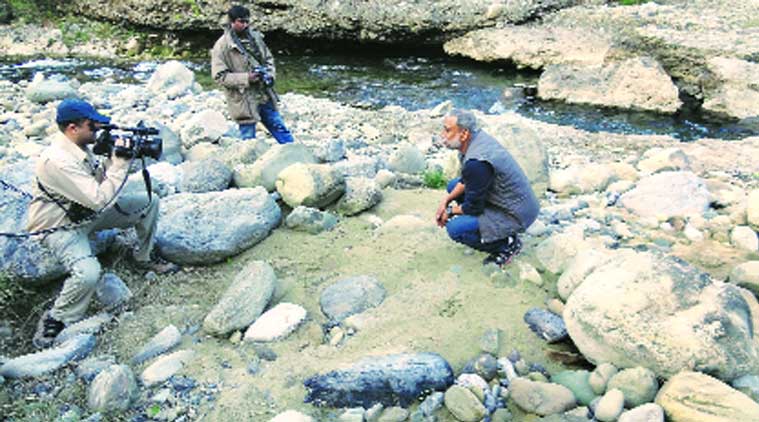 A working still from The Forgotten Tigers
A working still from The Forgotten Tigers
Written by Sankhayan Ghosh
| Mumbai |
Posted: December 19, 2014
In Krishnendu Bose’s documentary The Forgotten Tigers, Kahkashan
Naseem, the District Forest Officer of Ramnagar — which lies about 51
kilometres away from the well known tiger reserve Jim Corbett National
Park in Uttarakhand — says, “The Corbett tigers fall under ‘Above
Poverty Line’ and the tigers outside it, ‘Below Poverty Line’.” This
statement encapsulates the story of the film that ventures into an
uncharted territory. The magnificent beasts have been featured in many
coffee table books and films, but those are the big cats living inside
protected tiger reserves. Bose’s film is about the tigers outside the
gated boundaries of Kanha or Pench, where they roam around the fringes
of villages and towns.
“These account for about 30-50 per cent of the total tiger population of the country,” says Bose, whose 52-minute film goes on to make a larger statement about the dark side of India’s wildlife conservation policy. After the tiger population alarmingly dropped in 2005 at the Sariska and Panna tiger reserve, the measures taken by the government and policymakers ensured a surge in the number of tigers. But the tiger conservation strategy has proved to be myopic, says Bose, a wildlife and conservation filmmaker who has produced many award-winning documentaries.
As the forest areas have reduced, brought upon by rapid spread of urbanisation, and the number of tigers increased, the big cats have spilled over to outside protected tiger reserves. The increasing number of man-animal conflicts, killing of cattle and livestock and the reports of the tigers killed on railway tracks and roads, are a result of that. “The State has a Western way of looking at wildlife conservation, where you lock a certain area into a gated sanctuary with animals inside and humans living outside. That is suited for USA and Africa where they have vast stretches of forest land,” the Delhi-based filmmaker explains, “India is a patchwork of forest and habitation and we need to look at our policies in an indigenous way where deer, lions, tigers and rural folk peacefully co-exist.”
The Forgotten Tigers shows such stories that validate the argument. One such is of a village near Pench, Maharashtra, where an elderly man says that they don’t disturb tigers since they protect their farmlands from being harmed by pests and other mammals. The film was filmed for about nine months in Pilibhit, Lansdowne area of Uttarakhand, Western Ghats of Karnataka, Tadopa Tiger Reserve and Chandrapur, Maharashtra, Kanha National Park, Madhya Pradesh. Bose is in talks with Doordarshan for a telecast of his film next month.
source
“These account for about 30-50 per cent of the total tiger population of the country,” says Bose, whose 52-minute film goes on to make a larger statement about the dark side of India’s wildlife conservation policy. After the tiger population alarmingly dropped in 2005 at the Sariska and Panna tiger reserve, the measures taken by the government and policymakers ensured a surge in the number of tigers. But the tiger conservation strategy has proved to be myopic, says Bose, a wildlife and conservation filmmaker who has produced many award-winning documentaries.
As the forest areas have reduced, brought upon by rapid spread of urbanisation, and the number of tigers increased, the big cats have spilled over to outside protected tiger reserves. The increasing number of man-animal conflicts, killing of cattle and livestock and the reports of the tigers killed on railway tracks and roads, are a result of that. “The State has a Western way of looking at wildlife conservation, where you lock a certain area into a gated sanctuary with animals inside and humans living outside. That is suited for USA and Africa where they have vast stretches of forest land,” the Delhi-based filmmaker explains, “India is a patchwork of forest and habitation and we need to look at our policies in an indigenous way where deer, lions, tigers and rural folk peacefully co-exist.”
The Forgotten Tigers shows such stories that validate the argument. One such is of a village near Pench, Maharashtra, where an elderly man says that they don’t disturb tigers since they protect their farmlands from being harmed by pests and other mammals. The film was filmed for about nine months in Pilibhit, Lansdowne area of Uttarakhand, Western Ghats of Karnataka, Tadopa Tiger Reserve and Chandrapur, Maharashtra, Kanha National Park, Madhya Pradesh. Bose is in talks with Doordarshan for a telecast of his film next month.
source